|
Home
Articles
Reviews
Table of Contents
Search
Staff
| |
March 2017 - Buying your first Virtual Reality Headset
After decades of dormancy and a few recent years of development, virtual reality, or VR for short, has finally reached the consumer market. The top of the price range VR headsets might reach a little high, but some of the hardware can be jaw-dropping and there are options for every budget. Whether you’re looking to experience the immersion yourself, with a techie or gamer friend or blow your grandmother’s mind, this guide can be your opportunity to understand the lingo and devices available today. |
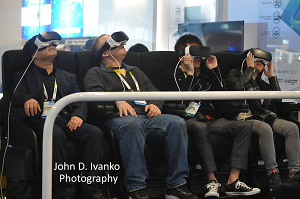 |
What is Virtual Reality?
Although virtual reality has existed for decades, it has experienced a reemergence in development over these last few years, thanks to more powerful smartphones and the Oculus Rift’s highly successful Kickstarter campaign. Now, there’s VR for the masses – and it’s impressive. Here’s a quick rundown of what you need to know about VR.
As the name implies, VR is a method of allowing users to immerse themselves into virtual worlds with a simple headset. VR works by having a small screen in a headset. The headset then utilizes gyroscopes and sensors to track your head’s movement and adjust the screen’s display to follow where you look. All of these components come together in a case that looks like a futuristic ski mask. The end result is an experience that can be so immersive it allows you to truly feel present in a virtual location ranging from a futuristic space cockpit to a roaring roller coaster ride. |
Virtual Reality’s Many Forms
VR headsets can take many forms. Picking the right form for you is the key to making your VR experience smooth, simple and within your budget. The style and level of VR you pick will make an impact on your time in VR. Your prerequisites, like your smartphone, computer, headphones and the amount of space set aside for VR, plus how much dough you’re gonna have to invest to make it happen, are also determining factors. On a basic level, VR devices are broken up into two types of headsets: standalone and tethered. |
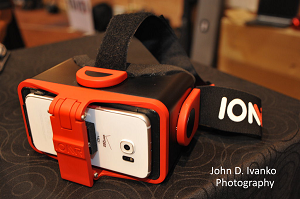 |
Standalone Virtual Reality
Standalone devices are headsets like Google Cardboard and Gear VR, that use a modern smartphone as the screen and also the engine to power these virtual worlds. This means that the headset is cheap — assuming you have a compatible phone — light and simple to use with minimal cables. The downside is that standalone units are more basic and far less immersive. Also be aware that due to the fact that it uses a smartphone, it can be a model-specific fit and you may have to look for a headset that fits your phone.
Because of the limited horsepower and screen of a smartphone, the graphics, refresh rate and field of view is reduced in VR. This graphical fidelity can be effected by your model of smartphone; a current generation smartphone will have a bit better experience compared to a phone a couple years old. With mobile VR, you lack the ability to be tracked beyond the direction your head is facing. This means leaning, walking and peering around a 3D object is not possible.
Standalone headsets can be readily found online and at local technology stores. They come in a variety of designs with compatibility for most smartphones available. Samsung’s Gear VR is the best standalone smartphone unit available but is only compatible with relatively current Samsung phones. Beyond the Gear VR, I haven’t found a huge difference in experiences in phone headsets from model to model. You can find decent plastic phone VR devices available for most models of phones for $15 to $60. It mostly comes down to cost and more subtle design choices. When looking for a phone based VR headset, here are some additional factors to keep in mind.
- Padding
No matter how long you intend to be using your VR headset, you’ll probably use it more than you think. So make sure that you take padding and comfort into consideration.
- Head strap
While a head strap may not be required for VR, holding the headset to your face can be an irritation and for most people, an immersion killer.
- Lenses
When trying low cost phone VR headsets, the lenses are what gives it much of its sense of presence. Though that may be true, the difference from lenses in these devices is very nominal. Don’t sweat the details.
- Headphone pass thru
If you want to get the most out of your immersion and experience, make sure that you have a nice pair of headphones and a hole for headphone pass thru on the headset positioned correctly for your model of phone. |
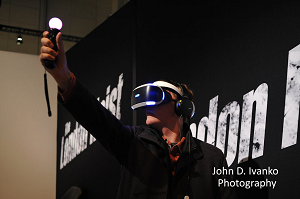 |
Tethered Virtual Reality
Tethered units refer to VR headsets that utilize external graphical power along with sensors to present a much more immersive experience at a steeper price. Some of the most common tethered VR headsets today are the Oculus Rift, HTC Vive and Sony PlayStation VR. Tethered VR devices achieve this level of graphics, tracking and immersion by handling all of the rendering on an external computer or gaming console.
The HTC Vive and Oculus Rift are compatible with expensive high end PCs and the Sony PlayStation VR works with the Sony PlayStation 4. The Vive (MSRP: $700, with controllers and sensors) and Rift (MSRP: $800, with Touch controllers and sensors) are the most immersive commercial gear currently available. The PlayStation VR (MSRP: $400, for the headset, with $160 extra for tracking camera and hand controllers) can be thought of as a midway point in terms of price and performance between standalone and tethered. The PlayStation VR also has the advantage of the estimated nearly 40 million PlayStation 4 consoles already in the hands of gamers. |
Recap of VR Options
Standalone VR units that use your smartphone present a compelling dip of the toe into the ocean that is VR. It won’t compare to tethered units, but at up to one tenth of the cost (not counting the cost of a phone, PC or PlayStation) they present a compelling entry into a futuristic technology. If you want to get or share a real taste of VR without going all in, take a look at the PlayStation VR, it offers a good experience for a nice middle ground in price.
If you’ve thought long and hard and believe that you want to go all in and buy a tethered unit like a Vive or Rift, you’ll be at the cutting edge and the first on your block to see the new games, experiences and apps as they’re released. Just make sure that your PC is powerful enough to handle it. |
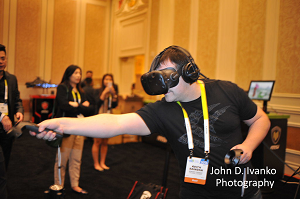 |
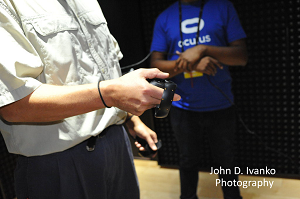 |
How VR Headsets Match Up
When you look at VR headsets of different tiers, competition is pretty tight. Standalone phone-based VR headsets are extremely similar in experience, leaving most of the choice on the shoulders of price and compatibility. Samsung’s Gear VR is a fantastic way to get a feel for the technology without making a substantial investment. The Gear may pale in comparison to the capabilities of the Vive, Rift or PlayStation VR, but it’s still the best VR experience available on a phone. Unfortunately, as with any item as tempting as this, there must be a catch. Gear VR is only compatible with Samsung’s modern Galaxy and Note series devices. |
If your personal phone preferences differ with the Gear’s requirements, no need to be heartbroken. A variety of manufacturers are making very nearly comparable headsets that are compatible with just about every smartphone. The first place to take look would be at a local technology retailer. If you find some headsets you like that are compatible with your phone, keep the elements mentioned in the explanation of standalone VR in mind and try one out. If you’ve got an older or uncommon phone that doesn’t have locally available headset options or even if you just weren’t impressed with a retailers options, take a look online. Digital marketplaces like Amazon are host to a diversity of mobile VR headsets; you’re much more likely to find one compatible there.
If you’re looking for a bit more impressive experience without going all in, take a look at Sony’s PlayStation VR. It’s good device, especially if you already own a PlayStation 4. It hooks up to your PlayStation 4, has the ability to track your body’s movements and works with PlayStation Move controllers for hand tracking in VR. |
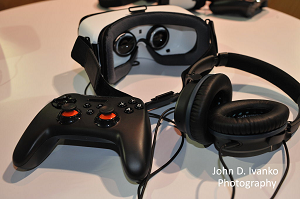 |
The focus of this article has been a comparison of the differences in hardware between devices. But, if you're interested in seeing a comparison of some of the software highlights across the platforms we've listed here, check out PC Lifeline’s Virtual Reality Platform Software Showdown.
When it comes to the matchup of the two top tier consumer tethered VR headsets, people will happily debate all day about the pros and cons of each. For the last year, the Vive has had a strong hand up on the competition with its wand shaped controllers that allows users to reach out and interact with the virtual world surrounding them. This changed when Oculus released their Oculus Touch controllers that allow Rift users to finally reach out and touch the digital landscape surrounding them. Having personally spent a significant amount of time with both the Vive’s controllers and Rift’s Touch controllers, I believe the Touch is superior to the Vive’s controllers. It comes down to a matter of personal preferences, though. The Rift has innovative controllers and the Vive currently has a larger area of space that can be tracked in VR due to its sensors. |
Liam Kivirist
is a freelance writer for national magazines and editor for TechSocket.net. Follow his work at LiamKivirist.com.
email him at:
If you like the photographs, take a look at John D. Ivanko Photography |
